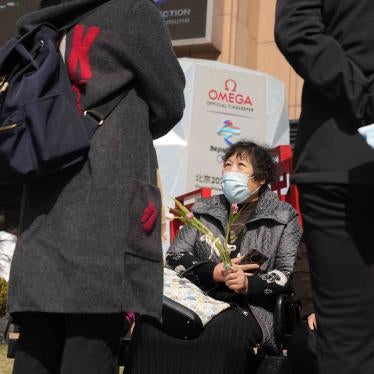July 2022
Human Rights Watch welcomes the opportunity to provide input to the Committee on the Rights of Persons with Disabilities (the “Committee”) ahead of its upcoming review of China. This submission highlights areas of concern that Human Rights Watch hopes will inform the Committee’s consideration of the Chinese government’s compliance with its obligations under the Convention on the Rights of Persons with Disabilities (CRPD). The submission relates to China’s compliance with articles 5, 6, 7, 12, 13, 14, 15, 16, 17, 19, 24, 25, and 26 of the CRPD. It proposes issues and questions that Committee members may wish to raise with the government of China.
Human Rights Watch is an independent, international human rights organization that monitors, reports, and conducts advocacy on human rights in more than 90 countries globally. Partnering with people with disabilities and their organizations across the globe, we work to ensure that the voices of people with disabilities are heard, in line with the disability movement’s motto “Nothing About Us, Without Us.”
Shackling of People with Psychosocial Disabilities (articles 5, 6, 7, 12, 13, 14, 15, 16,17, 19, 25, and 26)
In October 2020 Human Rights published a report, “Living in Chains: Shackling of People with Psychosocial Disabilities Worldwide,” documenting the practice of shackling of people with psychosocial disabilities in 60 countries around the world, including in China. The report found that globally hundreds of thousands of men, women, and children—some as young as 10—with psychosocial disabilities, or mental health conditions, have been shackled—chained or locked in confined spaces—at least once in their lives.[1] Many are held in overcrowded, filthy rooms, sheds, cages, or animal shelters and are forced to eat, sleep, urinate, and defecate in the same tiny area. The inhumane practice of shackling exists due to inadequate support and mental health services as well as widespread beliefs that stigmatize people with psychosocial disabilities. Shackling often occurs in homes because there are no services available in the community and families who struggle to cope with the demands of caring for a relative with a psychosocial disability may feel they have no choice but to shackle them. The time periods range from days and weeks, to months, and even years.
Government-controlled media in China reported between 2013 and 2017 that people with mental health conditions were shackled or locked in cages across the country, with approximately 100,000 “cage people” in the northern Hebei province alone, near Beijing.[2] In one case, an 8-year-old girl was tied to a tree by her grandparents for nearly six years in Henan province, in central China.[3]
In late January 2022, a video of a woman standing inside a dilapidated shack with a chain around her neck was published online and sparked outrage across China.[4] According to an official investigation, the woman, a mother of eight, was a victim of human trafficking. Media reported that she was chained after she developed a psychosocial disability.
The nature of shackling means that people live in very restrictive conditions that reduce their ability to stand or move at all.[5] People who are shackled to one another are often forced to go to the toilet and sleep together. Shackling impacts a person’s mental as well as physical health. A shackled person can be affected by post-traumatic stress, malnutrition, infections, nerve damage, muscular atrophy, and cardio-vascular problems.
Ying, a young woman from Guangdong province, in southern China, told Human Rights Watch in 2019: “All through my childhood, my aunt was locked in a wooden shed and I was forbidden to have contact with her. My family believed her mental health condition would stigmatize the whole family. I really wanted to help my auntie but couldn’t. It was heartbreaking.”[6]
Between 2005 and 2015, China implemented the “686” pilot program to provide basic mental health services on a large scale, which included an initiative to “unlock” people with psychosocial disabilities shackled in homes.[7] By 2012, the program had “unlocked” 271 people who had been shackled for periods ranging from two weeks to 28 years across 26 provinces.[8] The program demonstrated that accessible community-based mental health services were key to ensuring people remained free from chains, and that non-healthcare workers could be mobilized to deliver services in rural and low-resource settings. However, one of the main concerns about the 686 program was that it predominantly took a medical approach to mental health that focused on freeing people from chains and then admitting them to a psychiatric hospital for treatment or putting them on a regimen of mental health medication.
Under the 686 “unlocking” initiative, 266 people were given mental health medication and 88 percent of all those who were unlocked were admitted to a psychiatric hospital. As of 2012, 92 percent of the people who had been “unlocked” in China remained free from chains.[9] There is no publicly available current data on whether the people released by the 686 initiative remain free or whether they have access to ongoing support in the community.
Human Rights Watch encourages the Committee to ask the government of China:
- Is there official data on the number of people who are currently shackled or have been subjected to shackling in China?
- What steps has the government taken to eliminate the practice of shackling of people with psychosocial disabilities?
- What steps has the government taken to develop adequate, quality, and voluntary community-based support and mental health services?
- What have been the results of the 686 program since 2012? How many people have been freed from shackles and what has happened to them?
Human Rights Watch asks the Committee to consider including the following recommendations in its concluding observations on China:
- Ban shackling in law and in practice.
- Develop a time-bound plan to shift progressively to voluntary community-based mental health support, and independent living services.
- Comprehensively investigate state and private institutions in which people with mental health conditions live, with the goal of stopping chaining and ending other abuses.
- Create and carry out a deinstitutionalization policy and a time-bound action plan, based on the values of equality, independence, and inclusion for people with disabilities. Preventing institutionalization should be an important part of this plan. The government should include people with disabilities and their representative organizations in developing and carrying out the plan.
- Conduct public information campaigns to raise awareness about psychosocial disabilities and the rights of people with disabilities, especially among alternative mental health service providers and the broader community, in partnership with people with lived experiences of psychosocial disability.
Barriers to Education for Children with Disabilities (article 24)
In February 2017, the Chinese government released new Regulations of Education of Persons with Disabilities to replace the outdated 1994 regulations. Although the new regulations affirm that mainstream education is the preferred method for students with disabilities, they also require that children with disabilities be evaluated by a quasi-governmental Expert Committee on the Education of Persons with Disabilities, which places children in schools according to their “physical conditions and ability to be educated and adapt to [mainstream] schools.”
China’s Ministry of Education has long operated parallel systems of education for persons with disabilities: mainstream schools in which students with disabilities “study along with the class,” and special education schools in which students with disabilities are segregated according to types of disabilities.[10]
Human Rights Watch encourages the Committee to ask the government of China:
- What plans does the government have to move away from the parallel system of special education and guarantee quality, inclusive education for children with disabilities?
- How will the government reform the Expert Committee on the Education of Persons with Disabilities so that it does not discriminate against children with disabilities by directing them away from mainstream schools on the basis of their disabilities?
- How does the government plan to remedy learning time lost by children with disabilities due to Covid-19 related school closures?
Human Rights Watch asks the Committee to consider including the following recommendations in its concluding observations on China:
- Revise the Regulations on the Education of People with Disabilities to bring them in line with the Convention on the Rights of Persons with Disabilities. Specifically, the new regulations should state clearly that the Chinese government’s overarching goal in the education of people with disabilities is full inclusion on an equal basis with others at all levels of education. They should also establish a guarantee for provision of reasonable accommodations for students with disabilities in mainstream schools.
- Reform the Expert Committee on the Education of Persons with Disabilities to ensure that it does not discriminate against children with disabilities by directing them away from mainstream education but instead identifies the reasonable accommodations and supports that a child with a disability requires to receive a quality, inclusive education on an equal basis with others in mainstream schools.
- Develop a time-bound, strategic plan to establish an inclusive education system that delivers quality education, with specific indicators to measure access to education for children with disabilities.
[1] Human Rights Watch, Living in Chains: Shackling of People with Psychosocial Disabilities Worldwide, October 6, 2020, https://www.hrw.org/sites/default/files/reports/ghana1012webwcover.pdf.
[2] “Mentally Ill Confined at Home Due to Lack of Resources and Public Education,” Global Times, June 25, 2015, https://www.globaltimes.cn/content/928917.shtml (accessed July 28, 2020); “Caged People,” The Beijing News, July 11, 2013, http://www.bjnews.com.cn/feature/2013/07/11/272800.html (accessed July 28, 2020); “26-year-old ‘Mentally Disturbed’ Man in China Locked in Cage by His Parents,” Hong Kong Free Press, January 15, 2016, https://www.hongkongfp.com/2016/01/15/26-year-old-mentally-disturbed-man-in-china-locked-in-cage-by-his-parents/ (accessed March 19, 2020); “A Mentally Ill Chinese Man Has Been Locked In A Cage By His Family For 11 Years,” Business Insider, May 28, 2013, https://www.businessinsider.com/chinese-man-kept-in-cage-for-11-years-2013-5 (accessed July 28, 2020); “Chinese Mentally Ill Woman, Chained in Room for Decades by Family, to Get Medical Treatment,” South China Morning Post, undated, https://www.scmp.com/news/china/society/article/1815641/chinese-mentally-ill-woman-chained-room-decades-family-get (accessed July 28, 2020); Mimi Lau, "Caged in the woods: Chinese mentally ill woman locked up as family can’t afford treatment," South China Morning Post, January 24, 2017, https://www.scmp.com/news/china/article/2064898/chinese-mentally-ill-woman-forced-live-cage-woods (accessed January 7, 2021).
[3] Viola Zhou, “‘Mentally ill’ Chinese Girl, 8, Roped to Tree Outside by Grandparents for Nearly Six Years,” South China Morning Post, September 21, 2016, https://www.scmp.com/news/china/society/article/2021288/mentally-ill-chinese-girl-8-roped-tree-outside-grandparents (accessed July 28, 2020).
[4] “Kidnapped Mum of Eight Chained Like a Dog” (“被拐带而来的八个孩子的妈妈被像狗”), video clip, YouTube, January 28, 2022, https://www.youtube.com/watch?v=5npkIJ6NRr4 (accessed July 13, 2022); “Xuzhou mother: Video of chained woman in hut outrages China internet,” BBC News, January 31, 2022, https://www.bbc.com/news/uk-60194080 (accessed July 13, 2022); Aowen Cao, Emily Feng, “The mystery of the chained woman in China,” NPR, February 17, 2022, https://www.npr.org/sections/goatsandsoda/2022/02/17/1080115082/the-mystery-of-the-chained-woman-in-china?t=1657712122204 (accessed July 13, 2022).
[5] Human Rights Watch, Living in Chains, https://www.hrw.org/sites/default/files/reports/ghana1012webwcover.pdf, p. 4.
[6] Human Rights Watch interview with Ying (not her real name), November 2019 (location and details withheld).
[7] The Chinese government program to scale-up basic mental health services became known as “686” after initial funding of CNY 6.86 million. L Guan et al., “Unlocking Patients with Mental Disorders Who Were in Restraints at Home: A National Follow-Up Study of China’s New Public Mental Health Initiatives,” PLOS ONE 10(4) (2015), https://doi.org/10.1371/journal.pone.0121425 (accessed September 22, 2020).
[8] Ibid.
[9] Ibid.
[10] “China: New Rules for Students with Disabilities Inadequate: Modest Reforms Undercut by Provisions Allowing Discrimination,” Human Rights Watch news release, March 6, 2017, https://www.hrw.org/news/2017/03/06/china-new-rules-students-disabilities-inadequate.







